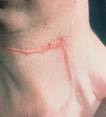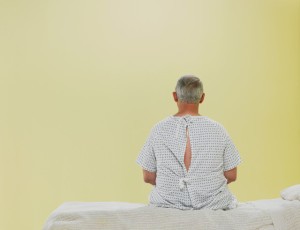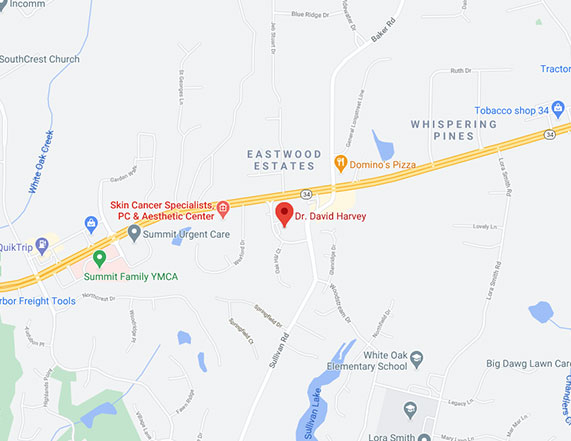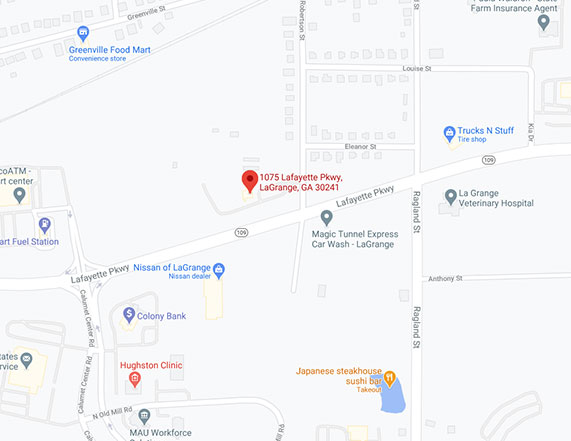Conveniently located to serve Newnan, Peachtree City and LaGrange
Click here to jump to:
Newnan Scar Revision
WHAT CAUSES SCARS TO HEAL DIFFERENTLY?
Scars – whether they’re caused by accidents or by surgery – are unpredictable. The way a scar develops depends as much on how your body heals as it does on the original injury. Many variables can affect the severity of scarring, including the size and depth of the wound, the blood supply to the area, the thickness and color of your skin, and the direction of the scar.
While no scar can be removed completely, we can often improve the appearance of a scar, making it less obvious through the injection or application of certain steroid medications or surgical procedures known as scar revisions. Dr. Harvey might perform V Beam, Z-plasty procedures, dermasanding, or CO2 laser to improve the appearance of one’s scars.
KELOID SCARS

Keloids are thick, itchy clusters of scar tissue that grow beyond the edges of the wound or incision. They are often red or darker in color than the surrounding skin. Keloids occur when the body continues to produce the tough, fibrous protein known as collagen after a wound has healed.
Keloids can appear anywhere on the body, but they’re most common over the breastbone, on the earlobes, and the shoulder. They occur more often in dark-skinned people than in those who are fair. The tendency to develop keloids lessens with age.
Keloids are often treated by injecting a steroid medication directly into the scar tissue to reduce redness, itching, and burning. In some cases, this will also shrink the scar. If steroid treatment is inadequate, the scar tissue can be cut out and the wound closed with one or more layers of stitches. You should be back at work in a day or two, and the stitches will be removed in a few days. A skin graft is occasionally used, although the site from which the graft was taken may then develop a keloid.
No matter what approach is taken, keloids have a stubborn tendency to recur, sometimes even larger than before. To discourage this, we may combine the scar removal with steroid injections, direct application of steroids during surgery, or radiation therapy. You also may be asked to wear a pressure garment over the area for as long as a year. Even with these approaches, the keloid may return, requiring repeated procedures every few years.
HYPERTROPHIC SCARS

Hypertrophic scars are often confused with keloids since both tend to be thick, red, and raised. Hypertrophic scars, however, remain within the boundaries of the original incision or wound. They often improve on their own – though it may take a year or more – or with the help of steroid applications or injections.
If a conservative approach doesn’t appear to be effective after approximately 9 months, hypertrophic scars can often be improved surgically. the doctor will remove excess scar tissue, and may reposition the incision so that it heals in a less visible pattern. You may receive steroid injections during surgery and at intervals for up to two years afterward to prevent the thick scar from reforming. Laser treatments can also be performed.
Related
Content
Patient
Review
“Dr. Harvey and his staff are excellent. He takes his time and connected with my daughter about her acne issues. The rest of his staff are just very sweet. We are so happy to have found this practice. I highly recommend them.”
by Anonymous
CONTRACTURES
Burns or other injuries resulting in the loss of a large area of skin may form a scar that pulls the edges of tissue together, a process that’s referred to as contraction. A contracture can affect adjacent muscles and tendons and restrict normal movement.
Correcting a contracture usually involves cutting out the scar and replacing it with a skin graft or a flap. In some cases, a procedure known as Z-plasty may be used. Tissue expansion procedures may also be used to reverse or minimize contractures.
FACIAL SCARS

There are several ways to make a facial scar less noticeable. Often it is simply cut out and closed with tiny stitches, leaving a thinner, less noticeable scar. If the scar lies across the natural skin creases (or “lines of relaxation”), Dr. Harvey may be able to reposition it to run parallel to these lines, where it will be less conspicuous.
Some facial scars can be softened using a technique called dermabrasion, a controlled scraping of the top layer of the skin using a handheld, high-speed rotary wheel. Dermabrasion usually leaves a smoother surface on the skin, but it won’t completely erase the scar.
Z-PLASTY
This surgical technique is used to reposition a scar so that it more closely conforms to the natural lines and creases of the skin, where it will be less noticeable. It can also relieve the tension caused by contracture.
THE PROCEDURE FOR Z-PLASTY SCAR REVISION

In this procedure, the old scar is removed and new incisions are made on each side, creating small triangular flaps of skin. These flaps are then rearranged to cover the wound at a different angle, giving the scar a “Z” pattern. The wound is closed with fine stitches, which are removed a week or two later.
While the Z-plasty procedure can make some scars less obvious, it won’t make them disappear. A portion of the scar will remain outside the lines of relaxation.
SKIN GRAFTING AND FLAP SURGERY
Skin grafts and flap procedures are more extensive approaches to treating scars. The treated area may take several weeks or months to heal, and a support garment or bandage may be necessary for up to a year.
THE PROCEDURE FOR GRAFTING
Skin grafting involves the transfer of skin from a healthy part of the body (the donor site) to cover the injured area. The graft is said to “take” when new blood vessels and scar tissue form in the injured area. While most graft procedures are successful, sometimes the graft doesn’t take. In addition, all graft surgeries leave some type of scarring at the donor and recipient sites.
Flap surgery is a complex procedure in which skin, along with the underlying fat, blood vessels, and sometimes muscle, is moved from a healthy part of the body to the injured site. In some flaps, the blood supply remains attached at one end to the donor site; in other flaps, the blood vessels in the flap are reattached to vessels at the new site using microvascular surgery. Skin grafting and flap surgery can greatly improve the function of a scarred area.

AFTER THESE PROCEDURES… WHAT CAN I EXPECT?
Keep in mind that no scar can be erased completely; the degree of improvement depends on the size and direction of your scar, the nature and quality of your skin, and how well you care for the wound after the operation. If your scar looks worse at first, don’t panic – the final results of your scar revision surgery may not be apparent for a year or more.
HOW MUCH DOES SCAR REVISION COST?
The cost of a Scar Revision will depend on several factors. The price can be affected by body type, type of technique performed, surgical complications, and even allergies. Find out more by scheduling a consultation.
HOW CAN I SCHEDULE A CONSULTATION OR TREATMENT?
For more information about scar treatments, please click here or call our office. Thank you and we look forward to helping you.
RELATED BLOG POSTS

Have Your Acne Scars Ruined the Texture of Your Skin?
Acne is a difficult skin condition to treat, which makes finding an effective treatment a satisfying victory. Unfortunately, that victory is short-lived for a lot of people. … Read More

What Is a Keloid Scar?
Keloid scars are characterized by their thick and discolored appearance. These clusters of scar tissue will extend beyond where the initial wound was made… Read More

Minimize Scarring After Surgery with These Four Steps
Surgeries can offer many life-saving and life-enhancing benefits, but scarring is often an unfortunate result of these procedures…. Read More











